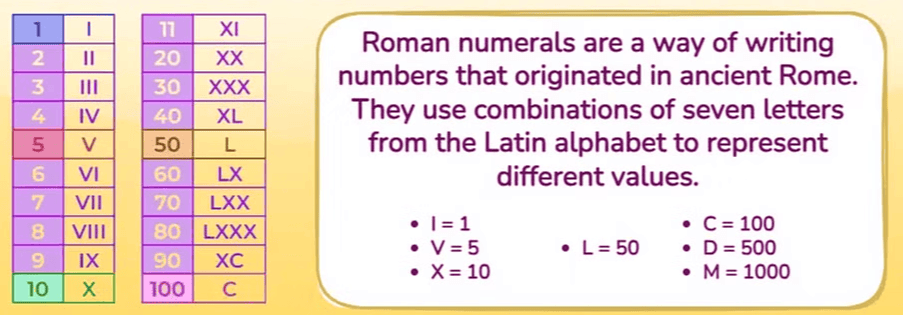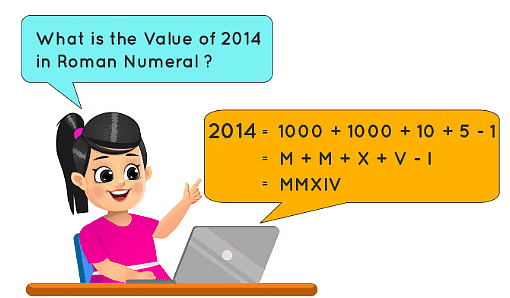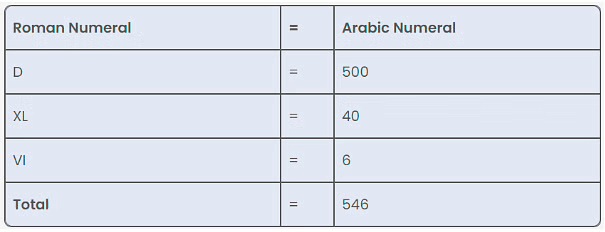Roman Numerals Class 4 Notes Maths
| Table of contents |

|
| What are Roman Numerals? |

|
| Rules of Roman Numerals |

|
| Roman Numerals Chart |

|
| Numbers to Roman Numerals |

|
| Roman Numerals to Numbers |

|
| How to Read Roman Numerals? |

|
What are Roman Numerals?
Roman numerals are a system that uses specific letters from the Latin alphabet to represent numbers. The ancient Romans used this system for counting, recording transactions, and various other numerical purposes.
 Roman Numerals
Roman Numerals
In this system:
- Roman numerals I, II, III, IV, V, VI, VII, VIII, IX, and X represent 1, 2, 3, 4, 5, 6, 7, 8, 9, and 10, respectively.
- After 10, the sequence continues with XI for 11, XII for 12, XIII for 13, and so on, up to XX for 20.
Roman numerals use seven primary letters to represent distinct values:
- I, V, X, L, C, D, and M, which correspond to 1, 5, 10, 50, 100, 500, and 1000, respectively.
Why Do We Use Roman Numerals?
Although Roman numerals originated in ancient Rome, they still appear in modern contexts such as clocks, book chapters, movie sequels, and important events. Learning Roman numerals helps us understand historical references and recognize certain traditional numbering systems. Roman Numerals on Clock
Roman Numerals on Clock
The numbers we normally use today, (0, 1, 2, 3, 4, 5, 6, 7, 8, and 9) were invented in India and spread to the world by Arabs. Hence they are called Hindu Arabic Numbers
Rules of Roman Numerals
Roman numerals follow a few basic rules, which are essential for both reading and writing them accurately. Here are three main rules to remember:

Rule 1: Rule of Repetition.
- When a symbol is repeated twice or thrice, its value also becomes twice or thrice respectively.
- Hence II is two, XXX (Ten + Ten + Ten) equals thirty and CC is (Hundred + Hundred) equals two hundred. However we must ensure some conditions
The conditions are:
- Symbols I , X and C can be repeated three times at maximum
- Symbols V , L and D can not be repeated.
 Rule of Repetition Examples
Rule of Repetition Examples
Rule 2: Rule of Addition.
- If a symbol of smaller value is written to the right of a symbol of higher value., We add smaller value to the greater value.
- For example, XI
Here I is smaller than X Hence we add them. ten + one = eleven.
XXV means (Ten + Ten + Five) = 25 - Example: What is the value of LV?
Ans: Here we get 50+5 equals 55.
 Rules of Addition: Examples
Rules of Addition: Examples
Rule 3: Rule of Subtraction.
- If a symbol of smaller value is placed to the left of a symbol with a higher value, the smaller value is subtracted from the larger value. For example, IV represents 4 (5 - 1).
Conditions:
- The symbols V, L, and D cannot be subtracted from other numbers.
- For instance, IV is valid for 4, but VX is not allowed for 5.
Note: Roman numerals do not include a symbol for zero.
 Rules of Subtraction: Examples
Rules of Subtraction: Examples
Roman Numerals Chart
A Roman numerals chart is a list that pairs Roman symbols with their respective values. In this system:
- The basic symbols are I (1), V (5), X (10), L (50), C (100), D (500), and M (1000).
 Roman Counting
Roman Counting
Roman Counting
- For example, LX represents (50 + 10) = 60, showing that symbols of equal or lesser value placed after each other are added.
- Conversely, symbols of lesser value placed before a greater symbol are subtracted, such as XL, which equals (50 - 10) = 40.
Numbers to Roman Numerals
When converting Hindu-Arabic numbers to Roman numerals, we break down the number into its components, match each component with a Roman numeral, and combine them.
Example 1:
- To write 2014 in Roman numerals: 2014 = 1000 + 1000 + 10 + 5 - 1, resulting in MMXIV.

Question: Write the following in Roman numerals.
(i) 34
(ii) 195
(iii) 276
(iv) 46
(v) 91
Sol: 
Roman Numerals to Numbers
To convert Roman numerals back to Hindu-Arabic numbers, split the Roman numeral into individual symbols, assign each its value, and combine through addition or subtraction.
Example 1:
- The Roman numeral MMLXVII can be broken down as follows: M + M + L + X + V + I + I
- This corresponds to: 1000 + 1000 + 50 + 10 + 5 + 1 + 1
- Adding these values gives the total numerical value: 2067

How to Read Roman Numerals?
Understanding and working with Roman numerals becomes straightforward by applying the rules mentioned earlier. To write Roman numerals in Hindu-Arabic numbers involves expanding the given Roman numeral and summing up its constituent values.
Example 1: Write the following Roman numerals in Arabic numerals:
(i) LXXVII
Sol:
(ii) XCIX
Sol:
(iii) DXLVI
Sol:
Example 2: Determine the value of XXVI.
Solution: Utilizing X = 10, V = 5, and I = 1, the expansion and addition result in X + X + V + I = 10 + 10 + 5 + 1 = 26.
Sol: Knowing that V represents 5 and I represents 1, and considering that I appears thrice after V, we add them together.
VIII=V+I+I+I
Thus, the time indicated is 8 o'clock.
Roman numerals are a system that uses specific letters from the Latin alphabet to represent numbers. The ancient Romans used this system for counting, recording transactions, and various other numerical purposes.
In this system:
- Roman numerals I, II, III, IV, V, VI, VII, VIII, IX, and X represent 1, 2, 3, 4, 5, 6, 7, 8, 9, and 10, respectively.
- After 10, the sequence continues with XI for 11, XII for 12, XIII for 13, and so on, up to XX for 20.
Roman numerals use seven primary letters to represent distinct values:
- I, V, X, L, C, D, and M, which correspond to 1, 5, 10, 50, 100, 500, and 1000, respectively.
|
33 videos|168 docs|30 tests
|
FAQs on Roman Numerals Class 4 Notes Maths
| 1. What are Roman Numerals and how are they used? |  |
| 2. What are the basic rules for writing Roman Numerals? |  |
| 3. How do you convert numbers to Roman Numerals? |  |
| 4. How can Roman Numerals be converted back to numbers? |  |
| 5. What are some common examples of Roman Numerals in everyday life? |  |





















